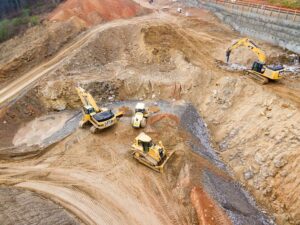Comprehensive Construction Site Safety Guidelines: Ensuring Excavation and Workplace Safety
Excavation and civil works rank among the highest-risk activities on any construction site, with trench collapses and utility strikes posing serious threats to worker welfare. By implementing robust construction safety protocols—from trench shoring to emergency response planning—project teams reduce incidents, maintain productivity and safeguard reputations. In this guide, you will discover essential excavation safety guidelines, local Kentucky health and safety regulations, advanced hazard identification techniques, fall protection best practices, heavy equipment safety protocols, safety management structures and how Earth Works, LLC reinforces a strong safety culture. Whether you oversee mass earthwork, site preparation, grading or utility construction, these workplace safety insights will equip you to minimize risk, comply with industry standards and deliver reliable, high-quality excavation services.
Comprehensive Excavation Safety Guide for Construction Sites
Excavation safety guidelines define the procedures and controls that prevent cave-ins, equipment incidents and underground service damage, thereby protecting workers and continuity of civil works. These guidelines establish a clear framework for soil assessment, support system design and daily inspections, improving risk mitigation and operational precision.
Before any digging begins, a competent person must evaluate soil properties and groundwater conditions and determine appropriate trench depths. A detailed excavation safety plan includes identifying buried utilities, selecting shoring or benching methods and assigning safe access points. Daily pre-shift inspections confirm that support systems remain intact and that spoil piles are positioned at least 2 feet (approximately 600 mm) from trench edges to prevent soil collapse. Finally, workers must be equipped with personal protective equipment and trained in emergency procedures, strengthening site resilience.
Below is a checklist of critical excavation safety measures:
- Conduct a soil stability assessment by a qualified inspector before excavation.
- Install shoring, shielding or battering systems based on trench depth and soil type.
- Use underground utility locators and confirm service markings prior to digging.
- Provide safe ladders or ramps at intervals no greater than 25 feet (approximately 7.5 meters) for trench access.
- Enforce mandatory PPE use, including hard hats, hi-vis clothing and safety boots.
These steps establish a solid excavation safety foundation and lead naturally into best practices for trench support.
How Can Trenching and Shoring Prevent Excavation Collapses?
Trenching and shoring systems support trench walls and prevent soil from caving in, protecting personnel from entrapment and severe injuries. By selecting appropriate support methods—such as hydraulic shores, trench boxes or timber shoring—operators maintain wall stability and adapt to varying soil classifications.
Comparative trench support features:
Each support method addresses distinct project requirements, ensuring excavation collapses are prevented through engineered controls that integrate seamlessly with site workflows.
The critical nature of trenching and excavation safety is underscored by research highlighting the persistent occurrence of incidents despite available controls.
Safety in Excavation and Trenching: A Training Resource for Worker Safety
Trenching and excavation are fundamental, and often essential, activities in construction that present some of the most serious safety hazards to those involved. This research employed a mixed-methods approach to identify the reasons for the continued occurrence of these incidents despite the availability of proven engineering and administrative controls, and the reasons behind the limited adoption of…
… : SAFETY IN EXCAVATION AND TRENCHING FOR YOU A TRAINING AND DECISION-MAKING TOOL FOR WORKER SAFETY IN EXCAVATION AND TRENCHING …, EC Hameen, 2024
What Procedures Minimize Risks of Underground Utility Strikes?
Minimizing underground utility strikes requires systematic locating, marking and safe digging techniques to protect communication, power and gas services. This process starts with obtaining as-built drawings, followed by non-destructive scanning and live service verification. Essential procedures include using electronic utility locators, hand-digging within proximity zones and maintaining clear communication with utility owners. Pot-holing to expose pipe or cable surfaces and verifying service depths ensures that mechanical excavators operate safely beyond marked zones. Applying these procedures mitigates service disruptions and expensive repair costs while promoting constant jobsite safety vigilance.
The complexity and potential for severe consequences associated with underground utility damage during excavation necessitate a thorough review of prevention measures.
Measures for the Prevention of Utility Damage During Excavation: A Comprehensive Review
It is frequently observed globally that excavation activities are an integral part of any construction project. A significant proportion of these excavations are associated with underground utilities. Excavation is commonly defined as an activity involving the creation of a void or the removal of soil or land, or the creation of a depth below the normal ground level, using specific mechanisms. Underground utilities are various systems through which substances or energy are typically transported. These excavation activities frequently result in accidents, some of which involve considerable property damage and fatalities. Such accidents commonly occur due to a variety of causes, including inadequate inspection, a lack of safe operating procedures, improper techniques, incompetence, cost-cutting by companies, and poor communication. However, these accidents can be largely averted through the use of specific factors or tools employed to identify their presence during excavation. Some of these tools include utility locators, ground-penetrating radar systems, adherence to safe work practices or procedures, continuous review of excavation work, training of personnel engaged in the work to enhance their competency, and the implementation or observance of statutory or legal requirements. Utilities encompass various types of systems, such as power cables, gas lines (which can be highly flammable and pressurised), and water supply lines. This complexity adds to the hazard during excavation work. Identifying the type of utility during excavation can sometimes be key to averting an accident. Damage to utilities by the excavation process often results in injuries, fatalities, power outages, project delays, and substantial repair costs, stemming from inaccurate perception of their visible location and depth. This paper reviews data concerning damage caused to underground utilities by excavation, the causes of such damage, the colour coding of different utility types, and utility damage prevention techniques.
Utility Damage Prevention Measures During Excavation: A Review, BP Yadav, 2022
How Is Safe Access and Egress Maintained in Excavation Areas?
Safe access and egress protect workers from falls and entrapment during entry and exit of trenches and excavations. Providing secure ladders, ramps or stairways at regular intervals ensures rapid evacuation if conditions deteriorate. Key access and egress controls include installing fixed ladders within 25 feet (approximately 7.5 meters) of any worker, railing trench tops to prevent falls and maintaining clear, obstacle-free pathways. Daily inspections confirm that access points are functional and free of debris. Establishing these controls reduces trip hazards and streamlines safe movement, creating a direct link to broader trench collapse prevention strategies.
Which Construction Health and Safety Regulations Apply to Excavation and Civil Works in Kentucky?
Kentucky excavation and civil works must comply with federal OSHA standards and complementary state regulations to ensure enforceable safety outcomes. Integrating both levels creates a regulatory framework that governs risk assessments, training and emergency planning.
Key regulatory comparisons:
Adhering to these regulations ensures excavations meet minimum performance criteria, which prepares teams for deeper safety management and documentation requirements.
What Are the Key OSHA Standards for Excavation Safety?
OSHA standards dictate that a competent person must inspect excavations daily and after any hazard-increasing event. Soil must be classified into Types A, B or C, and trenches deeper than 5 feet (approximately 1.5 meters) require protective systems unless in stable rock. Harnessing these standards promotes uniform safety performance across all excavation operations.
How Do State-Level Safety Requirements Complement Federal OSHA Rules?
Kentucky OSHA regulations reinforce federal standards by mandating additional record-keeping, toolbox talks and qualification credentials for safety officers. This layered approach ensures that safety plans are not only designed but continuously monitored through documented inspections and worker engagement initiatives.
What Are the Legal Obligations for Risk Assessment and Safety Plans?
Risk assessments and method statements (RAMS) must identify hazards, evaluate control measures and detail emergency response procedures. Projects exceeding prescribed risk thresholds require documented safety plans approved by a competent person, establishing accountability and legal compliance throughout civil works.
How Can Workplace Safety in Construction Be Enhanced Through Effective Hazard Identification?
Effective hazard identification establishes the basis for preventing accidents by systematically spotting and mitigating risks before they escalate. This process involves regular site surveys, hazard logs and corrective action tracking, which collectively reduce incident frequency and severity. By integrating scheduled safety walk-throughs, hazard registers and visual signage, project managers create dynamic risk management systems. Engaging workers in hazard reporting amplifies situational awareness and drives continuous improvement. Clear hazard identification leads directly into targeted control measures such as housekeeping and PPE protocols.
What Are the Most Common Construction Site Hazards and How Are They Mitigated?
The leading hazards include falls from height, trips on uneven ground and exposure to hazardous substances. Mitigation involves installing guardrails, marking walkways and enforcing COSHH-aligned chemical handling procedures. These controls curtail incident rates and underpin a proactive safety culture.
How Does Site Housekeeping Reduce Trip and Fall Risks?
Regular debris removal, material storage planning and ramp maintenance prevent trip hazards and uneven work surfaces. Scheduling daily housekeeping sessions ensures walkways remain clear, reducing slip-and-trip events and supporting uninterrupted excavation activities.
What Role Does PPE Play in Protecting Workers from Site Hazards?
Personal protective equipment—such as hard hats, safety boots, gloves and eye protection—creates a final barrier against residual risks that engineering controls cannot eliminate. Proper PPE selection and training enhance worker confidence and align with regulatory requirements.
What Are the Best Practices for Fall Protection on Construction Sites?
Fall protection encompasses engineered systems and worker training designed to prevent or arrest falls from height, addressing a leading cause of construction fatalities. By deploying guardrails, harnesses and safety nets, sites maintain continuous protection for personnel operating at elevated positions. Beyond equipment installation, fall protection best practices require thorough training in system use, regular equipment inspections and integration with site safety management. These combined measures create a comprehensive fall arrest program that bolsters overall site resilience.
How Are Fall Protection Systems Implemented and Maintained?
Installing guardrails at open edges, attaching lifelines to secure anchor points and deploying safety nets beneath work platforms form the backbone of a fall protection system. Routine inspections verify harness integrity, hardware compatibility and anchor stability to ensure readiness.
What Training Is Required for Working at Heights Safely?
Workers must complete a certified fall protection course covering hazard recognition, equipment inspection and rescue procedures. Competency verification through practical assessments confirms that personnel can don harnesses correctly and execute emergency retrieval operations.
How Does Fall Protection Integrate with Overall Site Safety Management?
Fall protection records feed into daily safety briefings, incident investigations and continuous improvement cycles. By linking system performance to risk assessments, project teams embed height-safety measures within broader safety culture initiatives.
How Does Heavy Equipment Safety Contribute to Construction Site Safety?
Heavy equipment safety reduces collision risks, roll-over incidents and struck-by injuries by ensuring operators follow strict protocols and maintenance schedules. Excavators, loaders and graders equipped with warning systems and maintained to OEM standards operate more reliably and safely. Implementing operator competency programs and pre-shift equipment checks ensures that machinery movements align with ground conditions and excavation plans. This focus on machinery safety directly supports excavation stability and site progress.
What Are the Key Safety Guidelines for Excavator and Loader Operation?
Operators must verify ground stability, maintain clear sightlines using mirrors and cameras and abide by manufacturer load limits. Establishing exclusion zones, using spotters and communicating via standard signals prevents unintended contact with adjacent personnel or utilities.
How Are Equipment Inspections and Maintenance Conducted to Prevent Accidents?
Daily pre-operation checklists assess hydraulic systems, brakes, lights and alarms. Scheduled maintenance based on operating hours and condition-based monitoring extends equipment lifespan and ensures safety systems function as intended.
What Communication and Spotter Procedures Ensure Safe Machinery Use?
Spotters use radios or hand signals from designated vantage points to guide machinery in congested areas. A standardized communication protocol eliminates ambiguity, ensuring operators adjust movements instantly to protect nearby workers.
How Is Safety Management and Emergency Response Structured on Construction Sites?
Safety management and emergency response plans establish the organizational framework for hazard control, training delivery and incident readiness. A safety management system includes risk assessments, method statements, toolbox talks and an escalation protocol for emergencies. Emergency response planning covers evacuation routes, rescue equipment staging and first-aid provisioning. Combining these elements ensures that teams can react effectively to injuries, structural failures or environmental hazards.
What Are the Components of an Effective Risk Assessment and Method Statement (RAMS)?
A RAMS document outlines scope, identified hazards, control measures, responsibilities and review dates. It assigns a competent person to oversee implementation and mandates regular reviews to incorporate new site conditions or regulatory updates.
How Are Safety Training and Induction Programs Delivered and Monitored?
Induction programs familiarize new personnel with site-specific hazards, safety policies and reporting procedures. Ongoing training sessions, toolbox talks and competency assessments track skill development and identify further learning needs.
What Emergency Response Plans and First Aid Measures Are Required?
Emergency plans designate evacuation assembly points, communication chains and rescue teams equipped with harnesses and stretchers. First-aid stations stocked with trauma kits and automated external defibrillators ensure critical care is available immediately after incidents.
What Demonstrates Earth Works, LLC’s Commitment to Construction Site Safety?
Earth Works, LLC embeds safety into every excavation and civil works project through comprehensive policies, continuous training and rigorous equipment management. This organization invests in top-of-the-line machinery, calibrated testing and certified safety programs to uphold its reputation for reliable, high-quality excavation services.
How Does Earth Works, LLC Foster a Strong Safety Culture?
Leadership at Earth Works, LLC conducts regular safety briefings, encourages hazard reporting and recognizes proactive safety behavior. This inclusive approach engages workers at all levels in continuous improvement and makes safety a shared responsibility.
What Safety Training and Certifications Do Earth Works, LLC Employees Hold?
Personnel complete accredited excavation safety courses covering trench shoring, confined space entry and fall arrest systems. Regular refresher training and site-specific simulations reinforce competence and readiness.
Which Case Studies Showcase Successful Safety Management on Projects?
Recent projects in Kentucky illustrate how Earth Works, LLC managed complex underground utility installations without incidents and completed mass earthwork phases with zero lost-time accidents. These success stories demonstrate the practical impact of robust safety procedures and professional project management.
Continued vigilance and proactive safety management transform excavation risks into predictable, controllable operations. By following these guidelines and embracing a culture of continuous improvement, construction teams deliver safe, efficient civil works that safeguard both people and project outcomes.


